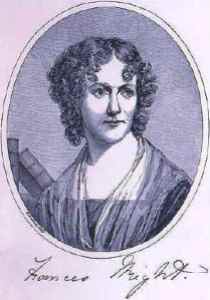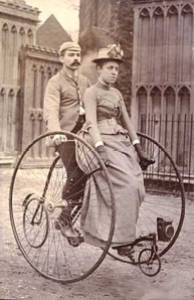“It will appear evident upon attentive consideration that equality of intellectual and physical advantages is the only sure foundation of liberty, and that such equality may best, and perhaps only, be obtained by a union of interests and cooperation in labor.” ~ Francis Wright
When the people gathered at Seneca Falls made their Declaration of Sentiments, and voted on their resolutions, the ideas weren’t new. There had been a number of women and men who had championed women’s rights over the years and laid the groundwork for the meeting in New York in 1848. The fact that Lucretia Mott could speak before a mixed group of men and women without ridicule, is testament to the fact that other women had paved the way. One of these women was Frances (Fanny) Wright.
Born September 6, 1795 in Dundee, Scotland, Fanny grew up well-taken care of, but somewhat isolated. Orphaned at the age of 2 and raised by relatives of moderate means, she was unusually well-educated for the time, partly due to access to a college library where an uncle taught. When she was 18, Fanny was introduced to intellectual circles in Glasgow and began writing poetry and plays. Thomas Jefferson filled pages of his commonplace book with quotes from her A Few Days in Athens, a fictionalized exploration of the philosophy of Epicurus, saying “it was a treat to me of the highest order.”
One thing that caught Fanny’s imagination was the new country across the Atlantic. Between 1818 and 1820 Fanny and her sister Camilla traveled around the new United States. They were well received into society, made many new friends, and even had Fanny’s play, Altorf, produced and published. To many it was a brazen act, having her name associated with a public production. On returning to Britain, she published an account of her travels as Views of Society and Manners in America. It was very complementary of the US and thus controversial as well. Fanny was becoming a woman to take seriously.
I think it’s fair to say she became enamored of the country and its possibilities. There was one blot, however, slavery. It disgusted her, but she seemed to understand the economic realities of the institution. In 1825, she wrote A Plan for the Gradual Abolition of Slavery in the United States Without Danger of Loss to the Citizens of the South. In it she details a plan to provide slaves a way to earn their freedom while developing skills and education they would need to make it as free individuals. She was unable to get support from the government for her plan, but she was willing to invest her own resources to put her plan to the test.
In 1826 with support from Lafayette and then senator Andrew Jackson, Fanny purchased acreage in Tennessee, near Memphis, and established her utopian community – Nashoba. Starting with just over 300 acres, 30 slaves, her sister Camilla, and ten white volunteers, they began the experiment. It was hard work and although unaccustomed to manual labor Fanny worked alongside the slaves and volunteers.
At the end of the first year, having been ill much of the time, possibly with malaria, she was in need of rest and a different climate, so Fanny returned to England to raise funds and support for her vision. While she was gone things fell apart. Accounts of harsh treatment of slaves, and sexual relationships outside of marriage and between whites and blacks, reached the newspapers and caused a general uproar among the public. Although Fanny’s unconventional views of marriage and sexual freedom meant that she was not overly concerned with much of the behavior, the community had drifted away from her original vision. It was not a success financially and they had been unable to sustain the atmosphere of cooperation and respect that she envisioned. In 1829, Fanny granted the slaves their freedom and transported them to Haiti where they could begin new lives.
Fanny moved to New Harmony, Indiana, another failed utopian settlement started by a friend from England, Robert Owen. Although the communal aspects of New Harmony were unsuccessful, it was still a secular community, where Fanny’s ideas were more welcome than in Tennessee. She joined Robert Dale Owen, the son, in publishing the New Harmony Gazette where she found a powerful vehicle for spreading her ideas. And she had plenty of ideas. Fanny spoke out for women’s rights, birth control, sexual freedom, equality between the sexes and races. She advocated a system of free, secular public schools, greater separation of church and state, and challenged organized religion.
On July 4, 1828, Fanny spoke at the Independence Day celebration in New Harmony. She was a tremendous success and decided to set out to take her message to others in the country. Not only was she an excellent writer, but she was an eloquent speaker. Frances Trollope said, “all my expectations fell far short of the splendor, the brilliance, the overwhelming eloquence of this extraordinary orator.” People flocked to hear her, some because they were interested in her ideas, but many because of the controversy. She was controversial, not only because of her topics, but because it was unheard of for a woman to speak in front of a mixed crowd, leading to accusations of “promiscuity” in her meetings and being called “The Great Red Harlot.”

After touring, Fanny and Robert Dale Owen relocated to New York, renamed the New Harmony Gazette the Free Enquirer and became leaders in the free thought movement and increasingly in the labor movement. Many of Fanny’s society friends distanced themselves from her, and as time went on the public became increasing hostile, even threatening. It was at this time that Fanny went to Haiti to relocate the slaves whom she had freed. She was accompanied on her trip to Haiti by Guillaume D’Arusmont. They became lovers and on her return she found that she was pregnant. Deciding that she couldn’t face the increasing hostility of the public, she left for Europe with Guillaume.
Fanny and D’Arusmont married, had one daughter, Sylva, and lived in a kind of self-imposed isolation in Europe. Eventually, in 1835, they returned to America settling in Cincinnati. After a brief speaking tour in support of President Jackson, where her appearance provoked near riots, Fanny retired from public life. She died in Cincinnati in 1852.
It would be easy to see Fanny’s life as a failure, but it takes time for new and radical ideas to take root in the consciousness of society, and there has to be someone who is willing to begin that process. Fanny Wright paved the way for women to speak in public rallies, edit newspapers, and represent radical causes. Each time one person speaks up, it makes it easier for the next person, and brings us closer to the goal.
“An opinion, right or wrong, can never constitute a moral offense, nor be in itself a moral obligation. It may be mistaken; it may involve an absurdity, or a contradiction. It is a truth; or it is an error: it can never be a crime or a virtue.” A Few Days in Athens (1822) Vol. II
Resources
A People’s History of the United States by Howard Zinn
The Utiopian Visions of Franny Wright
Frances Wright (1795 – 1852)



























